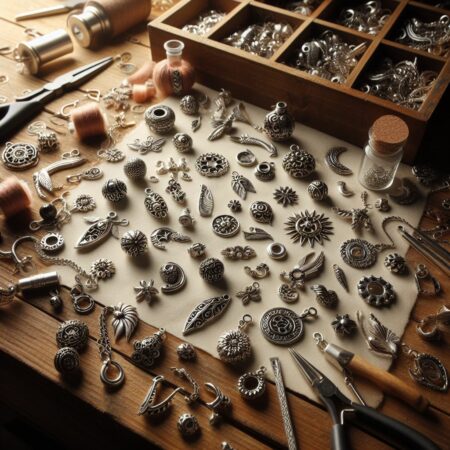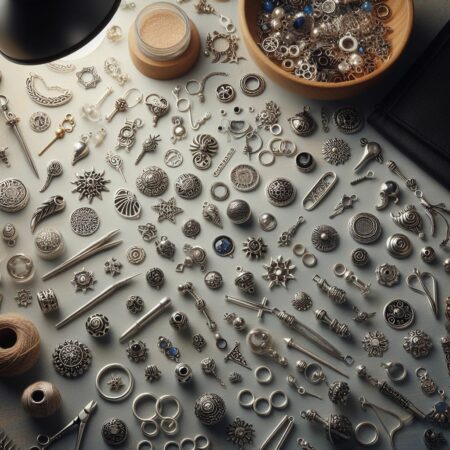Creative wire jewelry techniques allow you to be as creative as you want when crafting DIY jewelry! They also make it much easier to get started once you’ve learned a few fundamental wire jewelry ideas and wire jewelry patterns for beginners. Craft or jewelry wire comes in various materials, shapes, and wire gauges. Learning how to wire is important to your education as a jeweler. It’s also a good idea to familiarize yourself with the most important components in jewelry-making – the elements that make up bracelets and charms:
- Sterling silver charms
- Sterling silver beads
- Sterling silver findings
- Gold-filled beads
- Gold-filled findings
- Copper beads
- Copper findings
Wire Jewelry Techniques and Wire Gauges
A piece of wire’s gauge is essentially the measurement of its diameter. Wire gauge is frequently shortened as “ga,” thus 20 gauge is referred to as 20ga. Jewelry crafters use one of two popular wire gauge systems to determine the correct wire size for their projects.
In Canada and the United States, jewelry wire is often (but not always) measured in American Wire Gauge or AWG.
The measurement system is the Standard Wire Gauge (SWG) in the UK. Most European countries use millimeters to measure wire size.
Remember that the higher the gauge number, the smaller the diameter of the wire. This is since the numbers were derived from the number of times a length of wire had to travel through a draw plate before it was finished being sized. The wire becomes thinner as it passes through the plate more times. Therefore, the gauge number always runs inversely to the actual size or diameter of the wire. You will master this as you master other skills related to wire jewelry techniques.
What Gauge Wire for Jewelry Making?
It’s easy to buy wires, but it’s tough to determine how these wire gauges can be used for various projects.
For jewelry creation, the 32-gauge wire is incredibly delicate (thin). It can be used for wire weaving, bead crochet, Viking knit, and delicate coils, among other things. It can even be used to “stitch” beads and embellishments onto leather bracelets or metal blanks, just like sewing thread.
The 32-gauge bezel wire is ideal for wire jewelry ideas that involve setting cabochon stones and making no-solder resin bezels in various shapes and sizes.
The 30-gauge and 28-gauge wire are slightly thicker (and stiffer) than 32-gauge wire and are used for the same types of wirework.
Jewelry wires in the gauge of 26 are excellent for studying wire jewelry techniques. The 26-gauge wire is commonly used for wire weaving, and Viking knit, and it can also be used to “stitch” beads onto leather bracelets or metal blanks, like stiff sewing thread. In addition, it’s a popular wire size for pearls and tiny gemstone beads, which have smaller holes than larger beads.
The decent all-purpose wire diameter is 24-gauge jewelry wire. Wire 24 gauge is fine enough to pass through most gemstone beads and sturdy enough to construct good wire-wrapped loops. Note these in your notebook for wire jewelry techniques!
A decent general-purpose wire gauge is a 22-gauge jewelry wire. It’s too thick to fit through most pearl or tiny gemstone beads, but it’s strong and versatile enough for most other jewelry applications.
For many wire jewelry crafts that require a square wire, 21 gauge is a standard size.
The 20-gauge wire is a versatile, all-purpose wire that is thin enough to work with most beads. 20-gauge wire is also tough enough to keep its shape for constructing handcrafted chains, ear wires, eye pins, jump rings, and lightweight clasps if you use a half-hard wire (or work-harden dead-soft wire).In addition, 20ga wire can be used for bracelets and necklaces after work-hardened.
Sturdy clasps, jump rings, and other findings are made using 18 gauge jewelry wire. In addition, 18-gauge wire that is solid (not plated or filled) can be used to produce rivets. 18ga ear wires are also ideal for Eastern-style ear wires, or they can be drawn through a drawplate to form springy 20ga or 21ga ear wires, which are the standard size in the US.
The 16-gauge jewelry wire is a nice weight for necklace and bracelet wire and works well for constructing strong clasps and embellishments. 16ga solid wire (not plated or filled) is used to create rivets. 16ga gauge can be tough to bend depending on the metal.
Clasps, rings, cuff bracelets, and bangle bracelets are made with 14-gauge wire. It can also be used to frame resin and mixed media creations and provide structural support for various jewelry types. To create rivets, solid 14ga wire can be used. However, this gauge may be tough to bend depending on the metal. In many cases, 14-gauge wire is only available in a dead soft temper. Note this too, in your journal for wire jewelry techniques!
Jewelry wire in the 12-gauge range is quite heavy. As a result, bangle bracelets, cuff bracelets, rings, and neck collars are popular. It’s firm enough that you’ll want to use high-quality jewelry tools to mold it, but it’s not too difficult to work with. To keep bracelets and rings from bending out of shape, you may need to work-harden flexible wires like copper.
Shaping your jewelry into the desired shape can sometimes work-harden it sufficiently. Other designs may require you to hammer-texture them or use a wire whacker to finish them. It is typically only available in dead soft, and heavy-duty wire cutters or a jeweler’s saw may be required.
A heavy-gauge jewelry wire is ten gauges. It’s a suitable thickness for producing wire bangle bracelets, but some crafters’ hands find it too stiff to work with. It’s usually only available in dead soft, and cutting and shaping necessitate heavy-duty jewelry tools.
Wire Jewelry Techniques: Common Wire Shapes
When you look at a cross-section of a wire, you can see what it looks like (i.e., the cut end). This is one of the primary lessons in wire jewelry-making tutorials.
The most common wire shape is round wire, the typical shape used in most wire operations.
Square wire is occasionally used for purely aesthetic purposes, as the corners of square wire give completed jewelry a different aspect. However, when you wish to position numerous pieces of wire flush against each other, it also has a practical advantage. In wire jewelry-making tutorials, the square wire’s flat sides will lay flush in a way that round wire won’t. Square wire is therefore preferred in banding designs. You may also twist the square wire with a pin vise for a dazzling effect.
Typically, half-round wire links many nearby square wire segments. The rounded side is revealed in the finished design, while the flat side is placed against the square wires. This is referred to as banding.
Twisted (or fancy) wire adds texture and aesthetic aspects. It can be made up of round or square wires. You can buy the twisted wire already produced or manufacture your own using a pin vise or a Beadalon® wire twister. Remember that your completed fancy wire will be thicker gauge than the individual wires you start with when constructing your own.
Metals Found in Jewelry Wire
Your jewelry manufacturing wire can be constructed of various metals.
The most popular material for high-end jewelry and craft items is solid precious metal wire. .999 fine silver, Argenteum, and sterling silver wire are all options. Because Argentium is a tarnish-resistant metal, you and the end-user will spend a shorter time polishing!
Gold and silver fill overlay is another name for fill wires. They’re made by applying a thick coating of precious metal to a base of less expensive metal with heat and pressure (brass). Use these when producing high-end designs but don’t want to spend as much money on an actual precious metal wire. Despite not being solid, fill/overlay is usually termed precious metal since the precious metal cover is 100x thicker than a plating surface.
For crafting completed artisan jewelry, Solid Base Metal Wire is ideal. It’s also famous as a practice material and a technique for making precious metal prototypes. For all three of these applications, bare copper wire is particularly popular.
Stainless steel, nickel silver (also known as German silver), brass, and bronze wire are some of the other options. Of course, the color of your design will influence the base metal you use, but learning about the qualities of different metals will also help you decide. Learn more about the characteristics of base metals.
Hues that match precious metal elements without the added cost are available with German-style Silver Plate & Gold Plate Wire. When the plated wire is overworked, the plating can crack and chip, revealing the base metal beneath. As a result, plated wire works best in designs that don’t require a lot of bending and wrapping.
Enamel-coated wire comes in a variety of non-chipping, non-cracking colors. One of the most well-known brands is Artistic Wire®. It’s made of copper wire dyed with a permanent enamel coating. Between the enamel layer and the copper wire on the silver-plated colors is a layer of pure silver.
Silver-plated hues get a dazzling, high sheen from this. Unfortunately, artistic Wire is dead soft material. Although the finish will not chip or break, scraping through the colored layer is not recommended. Instead, many wire workers utilize nylon jaw pliers or use Tool Magic to treat their tooltips.
Bright hues are made in a chemical bath with anodized wire. The colors are more durable than plated colors since they are not plated. Scratching through the anodized coating should be avoided at all costs. Many wire workers utilize nylon jaw pliers or use Tool Magic to treat their tooltips.
Memory wire comes in various diameters and retains its round or oval shape (like the classic springy Slinky toy). Rings, multistrand bracelets, beaded wine charms, and chokers can all be made with it. Memory wire that is flat works well as a basis for beading.
Bullion (also known as French wire) is a finely coiled wire used to cover and preserve the end loops of bead cords. It comes in fine, medium, heavy, and extremely heavyweights. In addition, you can choose between sterling silver and base metals.
What are Half Hard Wire and Dead Soft Wire?
You may select “dead soft” or “half-hard” wire. Dead soft wire, as the name implies, is exceedingly simple to bend, even with your hands. When you try to bend half-hard wire, it provides some resistance. Dead soft wire has the advantage of being simple to form. The advantage of half-hard wire is that it holds its shape better once it’s been shaped.
A piece of wire will organically harden the more you deal with it. Work hardening the wire is the term for this process. You may be able to pound the wire to harden it once you’ve acquired the desired shape. For example, the wire can be given a dappled texture with a ball-peen hammer, flattened with a chasing hammer, and hardened with a nylon or rawhide hammer without changing the shape.
- Dead soft is ideal for creating spirals and flowing shapes.
- Half-hard angles are nice and crisp.
- Wire weaving and wire wrapping especially wrapped cabochons and “sculpted” wire jewelry, is commonly done with dead soft.
- Half-hard is ideal for creating components that must maintain their shape (ear wires, clasps, jump rings, necklace foundations, bracelet forms, etc.).
Gold-fill and silver-fill wire are often closer to half hard than dead soft sterling






